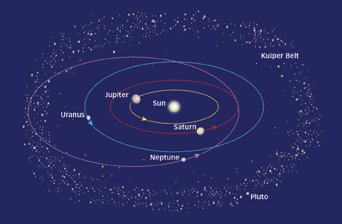Chaos Among the Planets
The screwball travels of four giant planets may have reshaped the early solar system.
Once upon a time, many, many years ago, the giant planets in our solar system took different paths around the sun than they follow now.
Jupiter, Saturn, Uranus, and Neptune were once bunched together and closer to the sun, says an international team of scientists. Under the influence of gravity, the planets broke out of their original orbits and began violently rearranging the outer solar system.
 |
|
A new theory suggests that the four giant planets, shown here in their current orbits around the sun, were once much closer together.
|
| Nature |
It’s “a fairy tale of the early solar system,” says Hal Levison. He’s a planetary scientist with the Southwest Research Institute in Boulder, Colo., and was one of the researchers who developed a computer simulation of the planets’ movements.
As the scientists tell it, the tale starts a few million years after the solar system’s birth. At first, the four giant planets had compact orbits. Neptune, for example, was only half as far away from the sun as it now. A slowly circulating band of ice, dust, and gas lay beyond these planets.
Ice, dust, and gas might not seem like much of a match for huge planets. But the researchers say that the pull of gravity between the particles and the planets caused the planets to gradually break out of their tight-knit group. Jupiter moved a bit closer to the sun, and the other three planets moved further away.
All was peaceful in the solar kingdom until the orbits of Saturn and Jupiter aligned so that Saturn took exactly twice as long as its neighbor to go around the sun. The increased gravitational tug of the two planets acting together caused an avalanche of effects.
Saturn’s orbit changed shape slightly, which threw off the orbits of Uranus and Neptune. The orbits of these two planets started looking like squished ovals. At times, the two planets even crossed paths.
And that’s when things got really crazy. Uranus and Neptune started hurtling through the band of ice, dust, and gas, scattering the debris throughout the solar system. The planets themselves ended up in their current orbits.
In the meantime, some of the scattered material became trapped around Jupiter, the scientists suggest. This could account for the presence of objects, known as the Trojan asteroids, that both lead and trail the planet.
Some of the debris could have been flung closer to our home, slamming into the moon and the solar system’s inner planets. This bombardment may have created the huge craters on the moon and elsewhere.
No one knows for sure whether all this really happened. But, by using computers to play complex games of “what if,” scientists can get a better sense of what might have happened to create the solar system as we know it.—K. Ramsayer
Going Deeper:
Cowen, Ron. 2005. Roaming giants: Did migrating planets shape the solar system? Science News 167(May 28):340. Available at http://www.sciencenews.org/articles/20050528/fob3.asp .
Sohn, Emily. 2004. Planets on the edge. Science News for Kids (April 7). Available at http://www.sciencenewsforkids.org/articles/20040407/Feature1.asp .
You can learn more about the birth of the solar system at www.earthsky.com/shows/shows.php?t=20050321 (Earth & Sky).







